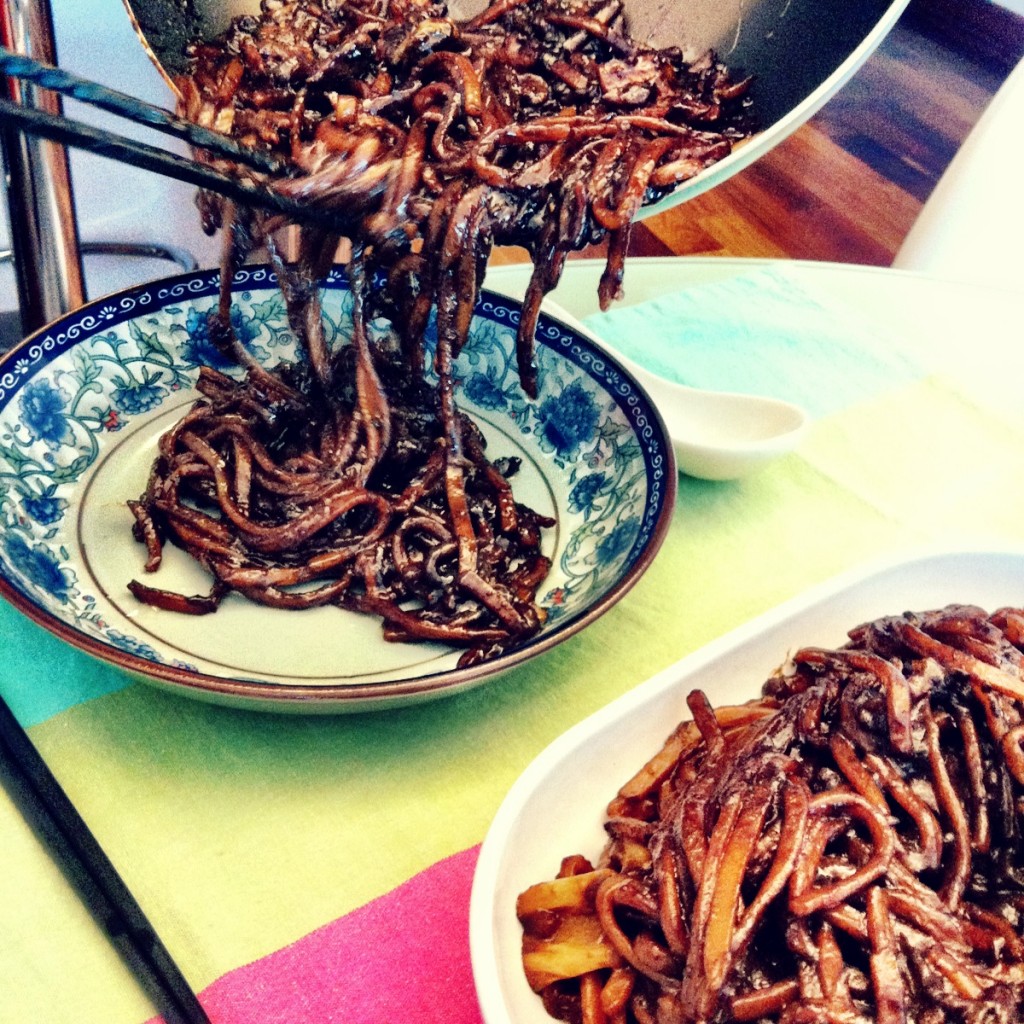Friendships should be rated on the Fried Hokkien Mee Index. A love for the thick noodles coated in silky black sauce, glistening with lard, with its smoky heady scent pushes one to the highest Friends-I-Can-Count-On-To-Name-Their-First-Child/Demon-After-Me rank while a response along the lines of “You mean the pale fried noodles served with prawns ah?….Yum yum…I tried it in Singapore!” gets one relegated to the Losers-I-Can-Count-On-To-Text-Me-While-They’re-In-The-Loo rank. Not happening.
One such person on the FICCOTNTFCDAM rank is HairyBerry. For as long as I can remember, our conversations have been peppered with the two most wonderful words known to mankind (“hokkien” and “mee”, in case I lost you at “lard” above) and eventually, it seemed like the natural progression of things to move on to the next level of our relationship.
We decided to cook hokkien mee together.
Sans recipe and equipped with only the memory of our hokkien mee-eating experiences, we met up early one morning to shop for ingredients. Not at the grime-ridden Selayang market, no sirree, but at the Village Grocer in Bangsar Village where one can find diced fried pork lard packaged in neatly stacked transparent plastic containers. There was a fair bit of quibbling about the ingredients that were required for our project as well as the quantities required, but we finally managed to come to an agreement and stocked up on the following items:
For the noodles:
Dark soy sauce
Light soy sauce
Oyster sauce
Fried pork skin
A tub of lard
Shallots – sliced
Garlic – sliced
Chinese cabbage – chopped roughly
Pork bone stock
Pork loin – sliced thinly
Prawns – peeled and deveined
Dried flatfish powder
For sambal belacan:
Red chillies
Belacan
Sugar
Lime
The experiment was conducted at our super secret air conditioned hokkien mee laboratory which was devoid of charcoal and wok in true city-dwelling style. The objective was to prove that 1) one can cook hokkien mee at home on a small gas burner without a wok; 2) anyone can cook; and 3) Village Grocer is heaven.
The shallots were sliced finely, then cooked with the pork lard to create a fragrant infused oil. While that was being prepared, we fried the pork loin in the pan, then removed it and set it aside. The same process applied to the prawns. We also blended the red chillies with belacan to make the sambal belacan. A little sugar was added to this paste. This was then fried with oil until the oil separated.
The stage was set.
Using a combination of cooking oil and lard, we fried some shallots and garlic in the frying pan, and then poured in some stock. In went the various sauces until the broth achieved the right colour, consistency and flavour, after which we threw in all the other prepared ingredients, the infused oil and the noodles. At this point, the noodles were left to braise in the covered frying pan for several minutes until the sauce thickened. More crunchy pieces of fried pork skin were added at the final point.
We made three batches, and all three batches tasted different thanks to our “agak-agak” style of cooking. One batch was horridly bitter due to the liberal amount of dark soy sauce used, while another tasted quite close to the original thing. We learnt that the braising time was important, as was the quality of the noodles used. One batch turned out too soft and lacked bite as a result of the long braising time.
Lessons were learnt that day, and we certainly didn’t expect perfect hokkien mee. On hindsight, perhaps we should have allowed some of our sweat to spill into the pan. We should have probably drunk more wine while cooking too, because I have learnt that I do my best cooking when I am inebriated.
On a scale of 1 to 10, I’d rank our hokkien mee a 5. Hairy and I will probably still be talking for years to come about our favourite hokkien mee stalls in KL and PJ, and we will probably not be embarking on another hokkien mee project in the next 36 months or so unless someone pays us a lot of money.
It’s a thankless job. Cooking, that is. How often do we thank our mums/dads who have had to plan daily menus and have had to ensure sufficient variety to avoid boredom at the dining table? I now understand how important it is to be thanked for food; it is an affirmation, not of your cooking skills (which you may possibly have little of), but of the effort that went into the preparation of a meal that can only come from the heart.
Oh, and Village Grocer is heaven.

